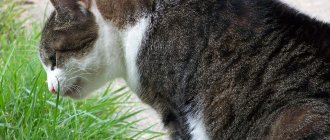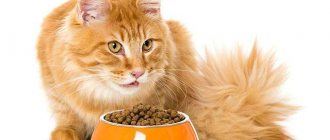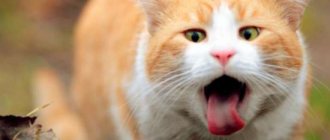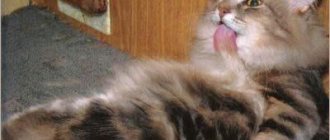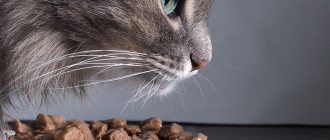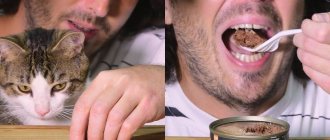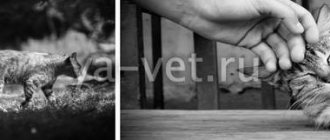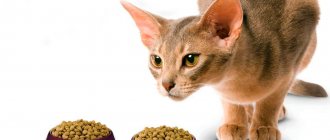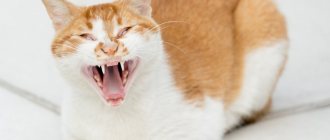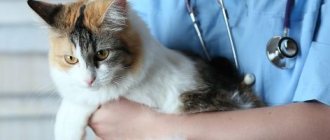There are many causes of nausea in cats: the accumulation of a large amount of hair in the stomach, poisoning with drugs and household chemicals, a foreign body in the gastrointestinal tract. However, if your pet is vomiting undigested food, the problem is most likely with the type and quality of the food.
We will find out the main causes of nausea and vomiting in cats, we will look at how to help your pet and how to prevent the reoccurrence of this condition.
Main reasons
Vomiting in a cat usually does not occur immediately. Regurgitation occurs in several stages:
- first there is a cough, which gradually intensifies;
- the cat feels anxious, performs unusual actions, for example, backing away;
- the pet begins to breathe frequently and constantly performs swallowing movements;
- at the very last moment he cranes his neck and bends down.
There can be several causes of vomiting in cats. Before starting treatment, you need to know the true reasons for poor health. It is very important to monitor your pet's condition and remember the events that preceded the onset of nausea. All this information must be told to the veterinarian during the examination.
Reflex vomiting
Occurs when the mucous membranes of the throat and palate become irritated by a foreign object that the cat may have swallowed.
Changing your diet
If your cat is vomiting after eating undigested food, it may be due to a change in diet. Most often this happens when changing the brand or type of dry food, during the transition from baby food to adult food, and then for older cats.
Changing your meal schedule
The structure of the cat's gastrointestinal tract requires the intake of food in small portions. If she is hungry, a large amount of gastric juice can leave the stomach, reach the oral cavity and provoke belching.
Interesting! Some breeds are considered prone to gluttony. Therefore, they require a clear nutrition schedule.
With frequent feeding or free access to food, some animals do not feel full and overeat. The food does not have time to be digested, the stomach becomes full, and the cat vomits after eating undigested food.
Spitting up fur
In the process of licking, cats, especially long-haired ones, swallow a considerable amount of hair. This is how a hairball forms in the stomach, which is then regurgitated. This is a normal physiological process.
Poisoning
Food poisoning in cats is diagnosed extremely rarely, as they are very picky. If the smell of food is not attractive, the pet will not eat. Therefore, kittens are more likely to suffer from poisoning.
It can be triggered not only by poor-quality food, but also by other substances:
- household chemicals;
- medicines;
- poison for mice and rats;
- fertilizers for plants or preparations for controlling garden pests;
- house plants.
Pregnancy status
A pregnant cat may vomit, but this is not due to toxicosis. In the later stages, the cat's gastrointestinal tract is compressed, and food flows back into the esophagus.
Infections
Domestic cats can become infected with infectious diseases:
- feline distemper or panleukopenia;
- enteritis (caused by coronavirus infection);
- calcivirus
Infection with worms
During their life, parasites secrete toxic substances that provoke vomiting after eating or in between meals.
Brain damage
When the brain is damaged in mammals, nausea occurs - this is where the vomiting center is located:
- tumors of the brain and membranes;
- concussion and bruise;
- increase in intracranial pressure.
What to do if your cat vomits undigested food
If a cat is vomiting from dry food, first you need to determine why this happened, and only then think about what to do in such a situation. A one-time adverse reaction rarely poses a visible threat to the kitten's health, but it is still a condition worth paying attention to. You can avoid such manifestations if you follow certain requirements:
- Feeding in small portions. Cats' stomachs are small, so they need a minimal amount of food to fully satiate.
- Checking the quality of food. You should not feed your cat dry food if its expiration date expired yesterday. One day of delay of a product can also lead to unforeseen consequences.
- Separate meals. Dry food is combined only with water; any other products, in particular dairy, can harm the stomach.
Only a correct and careful approach to organizing the cat’s nutrition will avoid serious complications.
Important! If high-quality food, separate feeding and control of overeating do not stop the vomiting, you should urgently contact a veterinarian. Often, regular vomiting of undigested food indicates serious disturbances in the functioning of the gastrointestinal tract.
How to help your pet
Veterinarians do not recommend treating a cat on your own in such a situation, but while waiting for an appointment with a doctor, it is important to understand what to do to make your pet feel better:
- provide the cat with constant access to clean and fresh water;
- give rice water, you can add boiled cereal to the food;
- include meat puree for baby food in the diet;
- feed the animal skinless chicken breast;
- Give your cat low-fat or low-fat cottage cheese.
It is recommended to follow this gentle regimen for at least 1 day. If vomiting does not recur, you can return to your normal diet. If your cat continues to burp, you will still need to visit a doctor.
Symptoms that require immediate veterinary attention
If other symptoms are combined with a cat’s vomiting of undigested food, the animal will need emergency veterinary care:
- nausea occurs after every meal;
- a small kitten that has not been vaccinated is vomiting;
- the cat constantly vomits, even if he does not eat;
- the animal’s body temperature has increased or, conversely, decreased;
- vomit has a foul odor or looks like feces;
- there are worms in the vomit or an admixture of blood or mucus;
- the condition is accompanied by seizures.
A cat regurgitates food: normal or pathological
Regurgitation of food is normal, but vomiting is pathological. Regurgitation occurs once or twice a day and not every day. The vomited material consists of food fragments or a white foamy mass. In this case, the pet is monitored and managed without the help of a veterinarian.
If attacks of vomiting occur 3 or more times a day or are repeated daily, this is a pathology that requires specialist intervention.
Diagnostics
If your cat vomits after eating, and this happens at least 3 times during the day, the veterinarian will order an examination. Before this, the owner must tell everything that has happened to the animal recently. It is worth paying attention to the following things:
- It is necessary to analyze what the pet ate and drank before it vomited for the first time. It is also worth remembering the medications and vaccines that have been introduced recently.
- It is important to understand whether the cat has access to household chemicals, cosmetics and home flowers.
- Clearly determine whether nausea occurs immediately after eating or over a period of time.
- By the composition of the vomit (food, gastric juice, uncharacteristic impurities) you can determine which food causes the reaction. Some cats vomit after eating food, but a natural diet does not cause such a reaction.
- The color of the vomit needs to be assessed.
- Pay attention to how the cat eats, whether it has an appetite.
- Before going to the doctor, it is important to note the nature of your animal's stool.
- The psychological situation should also be analyzed. Cats can react to moving, the appearance of a new person or animal.
Important! Both psychological and somatic changes in an animal’s life can equally provoke changes in its well-being.
Why does a cat vomit after feeding?
If, after the next meal, the cat vomits dry food and has general weakness and apathy, you should not immediately run to the veterinarian. To begin with, you just need to find out the source of the problem and observe the actions of your pet. A cat may vomit food for many reasons.
Binge eating
Cats do not experience a pronounced feeling of fullness, so overeating is one of the most common reasons that causes nausea and vomiting. This happens if the owner does not follow the rules of feeding the pet and offers him a non-standard portion of food.
When dry food granules enter the stomach, they swell, cause discomfort, and contribute to severe pain. An excess can cause not only discomfort in the stomach, but also nausea or vomiting.
Hasty eating
Many cats are very interested in eating, regardless of their level of hunger and body needs. This is why rapid ingestion of dry food can clog the stomach and is often accompanied by vomiting and general weakness.
If your cat does not know how to control the speed of eating, and often vomits after dry food, you can prevent such consequences in the following ways:
- reduce the amount of food, divide the daily amount of dry food into 5-6 meals;
- use a special bowl with ridges that will automatically slow down rapid eating;
- create a comfortable environment for your pet, make sure that there are no other pets near him during meals.
Compliance with these rules will eliminate the risk of overeating and consequences such as vomiting in the kitten.
Abrupt change of feed
Changing food is always stressful for a cat, which manifests itself not only in the form of lack of appetite, but also in the occurrence of nausea. If a cat vomits from a new dry food, the following reasons may contribute to this:
- intolerance to components;
- poor quality product;
- stressful situation.
Such consequences can be avoided by following general recommendations regarding changing food. You need to switch to a new product within 1-2 weeks, while gradually adding new food to the standard diet.
Expired or low-quality food
If your cat vomits dry food immediately after eating, the cause may be the expiration date or poor quality of the product. When purchasing food, you must pay attention to the composition, the ratio of animal and plant components.
The more ingredients of animal origin it contains, the tastier and better quality the dry food will be.
Food intolerance
If after eating a cat begins to vomit, he loses his activity and experiences general weakness, this indicates a food intolerance to the product. This can also be confirmed by stool disorder.
Attention! Often the cause of vomiting is not the food itself, but a separate component in its composition. Often it is a source of protein.
Mixed feeding
The combination of dry food with other products often provokes nausea in a cat, causes general malaise, loss of appetite and other symptoms. This is due to different processes of food digestion.
For example, a combination of dry food with dairy products, which require a lot of resources to break down, can cause illness.
In order not to encounter such a manifestation, it is necessary to dilute the food in separate portions, and do not mix several products at one time.
Treatment
Only a doctor can prescribe medications after examining the animal and talking with the owner. The process may include several stages:
- At first, from 6 to 8 hours, you cannot feed the animal.
- At the end of the break in food intake, a gentle diet is prescribed, depending on the diagnosis.
- The cat needs to be fed in small portions, and this regimen may have to be used constantly.
- The main diet should consist of boiled poultry, lean fish, rice and its broth.
- If your health improves, the menu can be gradually expanded.
- In case of poisoning, antiemetic and detoxification drugs are prescribed. They must be taken every day for the specified time and in accordance with the instructions for use.
It is important to monitor the progress of treatment with your doctor. If the condition worsens, a repeat consultation will be required.
Cat safety indoors and outdoors
Keep dangerous foods out of your cat's reach: fish and poultry, the bones of which can damage or block the digestive tract, onions, garlic, chocolate.
Many indoor plants are poisonous to cats, especially all bulbous plants (lilies, tulips), both in the ground and in cuttings.
No household chemicals, including rodents and insects, should be present.
Some cats swallow long objects (strands of garbage bags, rain trees, threads, ropes). A kitten playing with a ball is not an idyllic image, but rather a creepy one; it is better to opt for safe toys.
Walking down the street brings joy from new discoveries, but is also full of dangers, including the risk of poisoning...
How to avoid vomiting
If the reason your cat is vomiting is due to dietary errors, then to prevent repeated episodes you need to follow simple rules:
- if it is necessary to change cat food, this should be done gradually: daily replace some of the old with new;
- divide the daily dose of food into smaller portions, make meals more frequent;
- switch your pet to natural food if the food causes vomiting;
- If you have problems with fur, use special food for long-haired cats.
Vomiting in a cat is an indicator of problems in the organization of life. To eliminate this situation, you will need to analyze all aspects of keeping your pet and find the cause of the nausea.
If this has already happened once, it is important to constantly pay maximum attention to the quality of food and adherence to the nutritional schedule.
